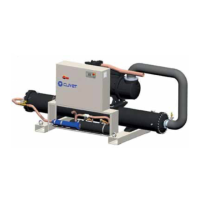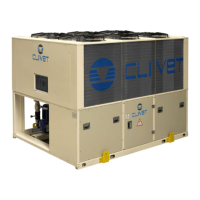
Do you have a question about the CLIVET SCREWLINE3 MDE-SL3 Series and is the answer not in the manual?
Discusses potential risks and the need for qualified personnel.
Emphasizes periodic inspection and maintenance.
Instructs immediate unit disabling and contact with service agent.
Provides detailed steps for safely handling the unit, including lifting.
Guidelines for unit installation location based on criteria like accessibility and load.
Warns about risks of refrigerant traps and potential explosion due to temperature increase.
Details supply line configuration for oil movement and insulation requirements.
Step-by-step procedure for checking refrigerant leaks using nitrogen.
Procedure for vacuuming the system, including checks for leaks or humidity.
Procedure for charging the system with refrigerant gas.
Details water quality requirements and potential issues with inadequate characteristics.
Advises on preventing freezing by using glycol or heating cables.
Specifies requirements for project water flow rate within exchanger limits.
Procedure for making hydraulic connections, including unions and joints.
Explains the function of the flow switch and its installation requirements.
Steps for making electrical connections, ensuring isolation and safety.
Illustrates power input connections and cable fixing.
Table specifying cable sections and tightening torque for power supply.
Instructions for connecting the unit to a PC for configuration and control.
Overview of start-up operations, responsibilities, and safety checks.
List of preliminary checks before unit start-up, referencing manual sections.
Detailed sequence of operations for unit start-up.
Checks for the refrigeration circuit, including oil stains and pressure.
Procedures for the water circuit, including cleaning, filling, and antifreeze.
Verification of electrical connections, conductor tightening, voltage, and phase balance.
Instructions for connecting and checking compressor crankcase heaters.
Procedure for limiting absorbed electric power using an external signal.
Procedure for modifying setpoint values for cooling, heating, and other modes.
Procedure for identifying, resetting, and managing alarms.
Table detailing inspection frequencies for various components and checks.
Table of periodical checks for screw compressors based on operating hours.
Explanation of alarm codes, types, modules, and inputs.
Details on ECOSHARE function for managing multiple units, including topology and cable specs.
Explanation of different operating modes for networked units.
Procedure for sending the unit to authorized centers for dismantling and disposal.
Risks associated with electrical connections, earthing, and contact with live parts.
Risks from refrigerant expulsion, explosion, and contact with heat sources.
Table of technical specifications for cooling capacity, power, and compressors.
Graph showing the unit's operating range based on water and condensing temperatures.










